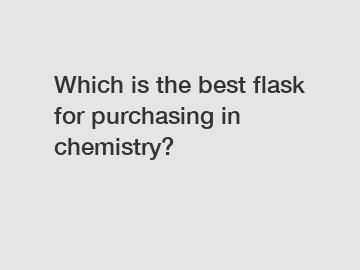Which is the best flask for purchasing in chemistry?
Which is the Best Flask for Purchasing in Chemistry?
When it comes to conducting experiments and performing chemical reactions, having the right tools is essential. One such tool that is commonly used in the field of chemistry is a flask. Flasks are versatile containers that come in various shapes and sizes, and they play a crucial role in holding and mixing liquids. With numerous options available in the market, it can be challenging to determine which flask is the best one to purchase for chemistry purposes. In this article, we will explore the different types of flasks and highlight their features to help you make an informed decision.
1. Erlenmeyer Flask.

The Erlenmeyer flask is perhaps the most popular type of flask used in chemistry laboratories. It has a conical shape with a flat bottom, angled sides, and a narrow neck. This design allows for easy swirling and mixing of liquids, making it ideal for reactions that involve stirring. Erlenmeyer flasks also come with graduations, which enable accurate measurements of liquids. The wide base provides stability, preventing tipping or spilling during experiments.
2. Round Bottom Flask.
Round bottom flasks, as the name suggests, have a spherical shape. These flasks are commonly used in distillation and reflux processes. The rounded shape allows for even heating and optimal boiling, making it suitable for reactions that require consistent temperature conditions. These flasks usually come with a single neck or multiple necks to accommodate different apparatus.
3. Florence Flask.
Florence flasks, also known as boiling flasks, have a pear-shaped design. They have a flat bottom and a long neck, making them ideal for heating and boiling liquids. Florence flasks are commonly used in applications such as heating solutions, preparing chemical mixtures, and carrying out reactions under reflux. The elongated neck minimizes the risk of splashing and helps in connecting with other apparatus.
4. Volumetric Flask.
Volumetric flasks are designed to provide precise and accurate measurement of liquids. They have a flat bottom with a long neck and a single graduation mark on the neck. Unlike other flasks, volumetric flasks are calibrated to contain a specific volume of liquid at a particular temperature, ensuring accuracy in measurements. These flasks are commonly used in analytical chemistry and for preparing standard solutions.
5. Filtering Flask.
Filtering flasks, also referred to as Buchner flasks, are specifically designed for vacuum filtration. They have a flat bottom and a side tube for connecting to a vacuum source. These flasks are used in various filtration processes to separate solid compounds from liquids. Filtering flasks often require the use of a Buchner funnel or a filter paper for efficient filtration.
In conclusion, the best flask for purchasing in chemistry depends on the specific application and requirements of the experiment. Erlenmeyer flasks are versatile and suitable for general laboratory use. Round bottom flasks are ideal for distillation and reflux processes, while Florence flasks are best for heating and boiling. Volumetric flasks provide precise measurements, and filtering flasks are essential for vacuum filtration. Understanding the purpose and characteristics of each flask will help you make an informed decision.
If you have further questions or need assistance in selecting the right flask for your chemistry needs, please do not hesitate to contact us. Our knowledgeable team will be happy to help you find the best flask for your specific requirements.
If you want to learn more, please visit our website cell culture consumables, erlenmeyer flask used in laboratory, what are serological pipettes used for.

Comments